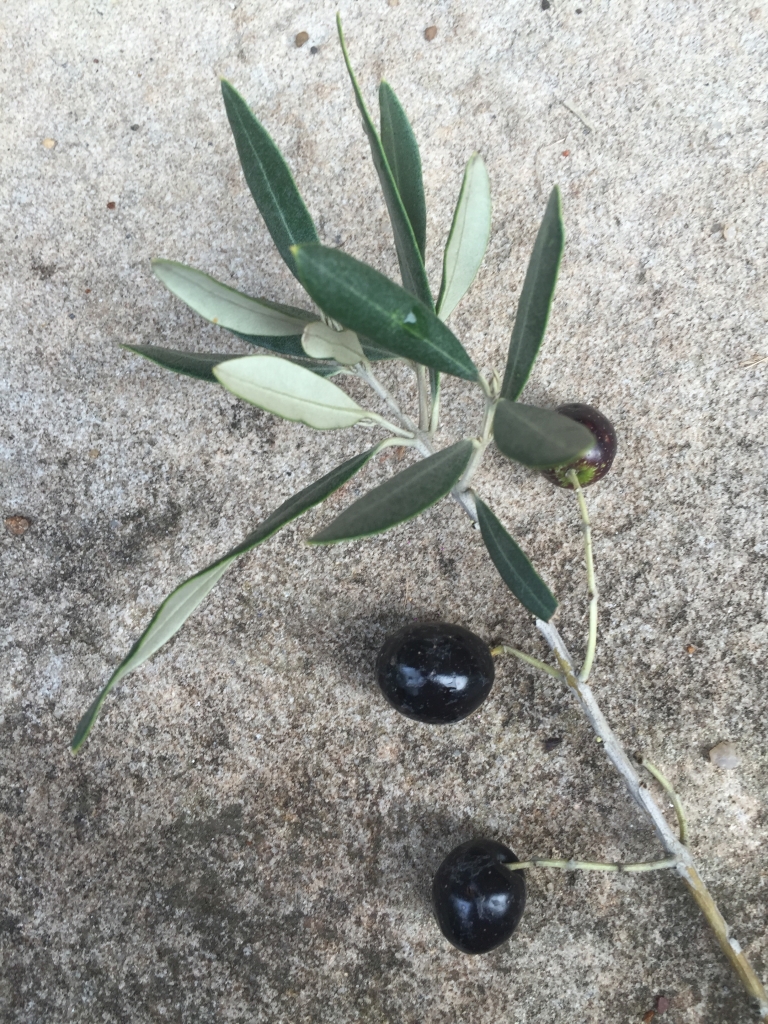We’ve chatted before about the prodigiously old olive tree at Elizabeth Farm. This past week it did something very unexpected – it bore fruit!
The olive tree beside the carriage loop at Elizabeth Farm is quite likely the oldest in the country, planted in 1805 having been brought back to the colony from Europe by John Macarthur on board the Eldon.

Elizabeth Farm with olive tree front right. Photo © James Horan for Sydney Living Museums
What we see today is not the first trunk; a photograph taken around 1900 shows the original tree – a European olive – still growing as a single-trunked specimen prominently in front of the house.
Long view of Elizabeth Farm showing olive tree c1900-1908. Photograph by Mrs A.G. Foster_State Library of NSW PXA 182 image no21
What we see today are more recent suckers, growing from the original root-stock and surrounding the first trunk’s stump. Visitors ask if it has borne fruit; in all my time at Elizabeth Farm I’ve never known it to develop more than scrawny, wizened examples, and not many of them. Until this week.

Olives from the tree at Elizabeth Farm. Photo (c) Scott Hill for Sydney Living Museums
There may not be many of them, but the younger, vigorous suckers have suddenly produced fruit; fleshy, plump black olives. Around 2cms across, they can be seen scattered across the upper branches. I say ‘younger’ suckers, but these are around 2 decades old, which is the time that olive trees take to bear fruit – they’re a long term investment.
A family ambition
In 1830, while visiting England, James Macarthur wrote to his father back in NSW:
…Edward is making an Extract from Jefferson’s Memoirs and Correspondence on the subject of the Olive and Caper which will I am sure be highly gratifying to you. For to you my dear Father will truth (which in the end must prevail) assign the honor of introducing the Olive – The cause of the ill success of our Caper is I think satisfactorily explained by its exposure to the frosts.’
James Macarthur to his father John, 22 June 1830 – ML A2931. James Macarthur – Letters to Relations 1827 – 1855, Macarthur Papers, SLNSW
The ‘Jefferson’ is of course Thomas Jefferson, 3rd President of the United States of America. He had published his considerable memoirs, and James’ eldest brother Edward was making a selection of quotes relating to olive cultivation and olive oil production to send to his father. Jefferson had hoped to introduce the olive to North America, promoting its cultivation and create an oil industry. Echoing the Macarthurs’ efforts it was a short-lived attempt, as the harsh winters killed the trees of his Italian neighbour, and American farmers were more interested in a crop with a significantly faster return. Jefferson wrote of the tree he esteemed that it was “surely the richest gift of heaven”.
For the Macarthurs, with a great love of plants, it was surely a matter of time, of patient trial and error until they achieved success. Writing from England, John Macarthur Jnr wrote to his sister theorising on the likely success of acquiring trees from Tasmania, that had already ‘acclimatised’:
‘… If any English fruits have been grown in great perfection in Van Dieman’s Land, young plants from that island would stand a chance of succeeding better than from this country, because according to the received opinions, they will have been gradually prepared for the change of climate. According to the rule also each generation of the olive and the vine should flourish better than the parent stem …’
30th April 1821, John Macarthur Jnr. to his sister Elizabeth Macarthur. (SLNSW, ML A2911: John Macarthur jnr. Correspondence 1810-1831)
The family had success, at least by May 1831 when Elizabeth Macarthur wrote:
…At Parramatta there is a great change for the better in Aunt Eliza’s garden, as the children call it, even William pays a tribute to your sister’s perseverance and attention to horticulture. Our Portugal laurel has blossomed beautifully this year. We have made a small quantity of olive oil and we have had capers for our boiled mutton.’’
12th May 1831, from Sydney. (SLNSW, ML A2906: Mrs John Macarthur – Journal and Correspondence 1789-1840)
Shadowy olives
Neoclassical olive wreath motif in shadow work embroidery at Elizabeth Farm. Photo (c) Scott Hill for Sydney Living Museums
The tree may have suddenly fruited, but Elizabeth Farm already had olives – well, in a manner of speaking.
In the house’s dining room closet, the small room at the west end of the main verandah, the muslin curtains have been embroidered in a neoclassical motif of a continual olive wreath by our Soft Furnishings Group. Taken from ancient Greek pottery, the motif isn’t just a curator’s aesthetic whim: the Macarthur crest is actually surmounted by an olive wreath. Looking out through the main windows we see the olive tree itself, framed in shadow-work leaves and fruit.
So are we about to tuck into the olives? Not quite… They would need to be soaked in brine for several months, and looking at the tree we might just manage enough to fill a few small bottles. Still, its an excellent omen for the life ahead of this Elizabeth Farm icon.



